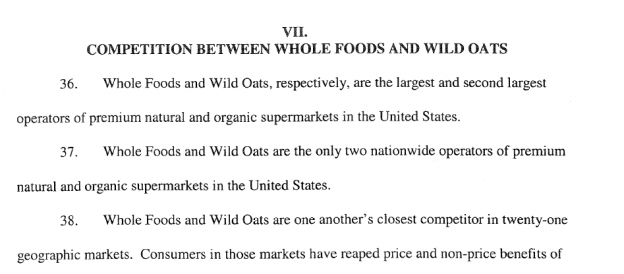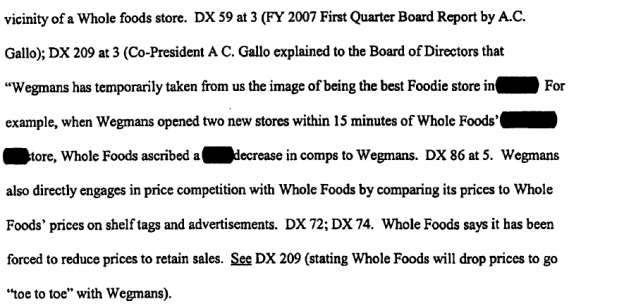Time to look closer at this because, well, no one else is.
The Skinny:
Simon Properties gaining even partial control of GGP and its 200 malls would mean Simon Properties (SPG) would have an effect on nearly 50% of the Class A US Mall Market or a monopoly.
Case Study:
Whole Foods / Wild Oats Merger, 2007
Whole Foods proposed the purchase of 190 Wild Oats locations on 2/21/2007 for $691m in cash and stock. WFMI proposed to convert Wild Oats stores to Whole Foods, close some and sell others off.
After a review, on JUNE 5, 2007, the FTC challenged because they claimed the deal would cause the combined entity to have a monopoly in the “operation of Premium Organic Food supermarkets” (read: Class A US Malls in SPG/GGP)
In its complaint the FTC said (click to enlarge):

Insert the word “mall” for “premium and organic natural food” and you now have SPG & GGP
Here is the FTC’s complaint (click to open .pdf):
Wild Oats & Whole Foods FTC Complaint
Ahhhhh… you say, BUT, the FTC lost that case and in August of that year the injunction they sought was denied and the deal closed on August 27th, 2007, six months after it was announced (the two are still wrangling in court over it).
The key is why it was denied. In his finding the judge stated (click to enlarge):

Whole Filing (click to open .pdf):
FTC Denial
Note the Judge did NOT say the integration of the two did not create a powerhouse. Rather, he said that the competition had spent billions to upgrade their own offerings to compete with the new Wild Oats/Whole Foods and that the Premium Organic market has expanded to a point the merger did not create a monopoly.
In fact a key point in the case was a Q1 2007 report from Whole Foods Co-Pres. stating (click to enlarge, redactions from court docs):

At that time initiatives to enter the “perishable organic foods” market by Wegman’s were already having a negative impact on Whole Foods. That gave the judge evidence the market Whole foods operated in was expanding fast. The FTC, using past data was correct in its assumptions of the market at the time of the data. The problem is the grocery market was so rapidly changing and dynamic, that between the time the deal was announced and the July court date, a sea change had begun in the business.
Why does this matter? In the SPG/GGP scenario, this reasoning does not exist. When the FTC challenges this deal if SPG is the winner, a Judge cannot say that a slew of Class B malls are now becoming Class A and that the SPG/GGP merger is no longer a monopoly. The number of Class A malls is stagnant and may even decline in 2010-11 given recent CRE trends. In the two cases the key difference is that the market in WFMI was expanding at an unprecedented pace and in GGP/SPG it isn’t and in fact may contract. Even if one wants to go out on a limb and include all of CRE, there still is little debate the amount of stable, quality options for retailers will shrink in the near future.
If a decline does happen, the market share of the GGP/SPG portfolio will grow even larger. In fact it is of little debate that there will a reduction in general in retail CRE this year leaving retailers with fewer options. Fewer options and and a consolidation of ownership in Class A malls would place retailers at a competitive disadvantage.
One could also assume the proposed combination of #1 and #2 will have an even larger effect going forward.
So, what does it all mean?
On the 29th Gropper will make a decision (most likely). He will decide whose offer is the best based on the merits of both. NOTE: everything I now say is based on both offers as they are as of this minute. If either one changes materially tomorrow, we will need to revisit it.
The price on the two offers is essentially the same. The drawback to the BAM offer is the 120M warrants. The drawback(s) to the SPG offer are:
1- The possibility of SPG backstopping ~$3B in shares it will eventually sell to get share ownership down to the 20% level of their capped voting interest. This creates a “supply overhang” for shares well in excess of the warrants issued to BAM.
2- No clear plan for the GGO spin off. Brookfield has said would eagerly appoint management to assist running it should GGP desire. SPG has announced no plans other that the stock purchase.
3- No clear ownership plan from potential investor groups. BAM/FAIRX/Pershing have all said they want GGP to emerge independent and want to be long term owners of the equity. There have been no such statements from the SPG group. It is unclear if they wish to be owners or are simply speculators wishing to flip shares.
4- FTC. See above. Gropper has to weigh the possibility of a six to 9 month delay should the FTC get involved when picking a plan. Also, under the SPG plan, they would have the right to pull out of the offer should the FTC require them the dispose of a significant portion of the malls leaving the process back to square one. This significant issue is non existent in the BAM plan.
If Simon wants to be a significant equity owner in GGP, it can still do so even if its offer is not accepted. Let SPG deal with the FTC outside of the GGP Chapter 11 process. If the FTC looks at it and then decide a partial stake is ok, then I am sure SPG could essentially get the same equity deal it is offering now for a billion dollar plus commitment.
For those reasons, based on what we have NOW, IMO the Brookfield offer is far superior as it offer current shareholders far more certainty now, than the SPG offer and far more ownership stability post Chapter 11 emergence.